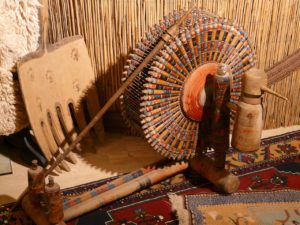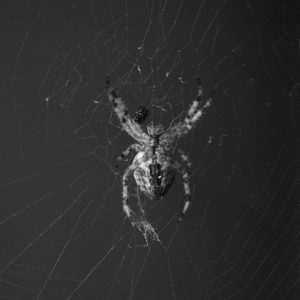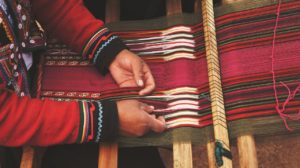‘To spin a yarn’ we say, meaning to tell a story. Or ‘to weave a tale’.
The dictionary definition of ‘to weave’ includes ‘to make by  crossing threads, strands strips… to interlace…to work into a fabric, story etc.‘ ‘To spin’ is ‘to draw out and twist into threads‘.
crossing threads, strands strips… to interlace…to work into a fabric, story etc.‘ ‘To spin’ is ‘to draw out and twist into threads‘.
Or, to paraphrase, drawing out things or ideas and refining and combining them with other things or ideas to make a new whole (which is greater than the sum of its parts). Thus weaving becomes a metaphor for creating any structure, or structured thing.
It’s hardly surprising that we use these words when describing the act of writing; and stories have often used spinning and weaving as metaphors. Both verbs have Old English roots – spinnen and wefan, coming originally from even older Germanic languages. The practices which they describe are old too, the spinning and weaving of fabric has been going on since humans began to settle and there is evidence of weaving in Paleolithic times (27,000 years ago).
The song of the Peasant’s Revolt (in 1381) began ‘When Adam delved and Eve span‘, which is testament to just how old we deem spinning (and weaving) to be. Both appear in stories  from the earliest times. In Greek myth Arachne spins her web-like fabric, Ariadne unwinds her spool of thread as she walks through the labyrinth and in Homer Penelope unwinds the day’s woven cloth each evening as she waits for Odysseus’ return. Exiled Jews weave in the Old Testament wilderness in Leviticus, while the woven carpets of the ancient Persians offer transports to exotic lands in The Arabian Nights.
from the earliest times. In Greek myth Arachne spins her web-like fabric, Ariadne unwinds her spool of thread as she walks through the labyrinth and in Homer Penelope unwinds the day’s woven cloth each evening as she waits for Odysseus’ return. Exiled Jews weave in the Old Testament wilderness in Leviticus, while the woven carpets of the ancient Persians offer transports to exotic lands in The Arabian Nights.
One can describe writing as the warp¹ and weft² of a story. For this particular writer the basic plot is the warp, the action that  happens in the story and the weft comprises the thematic and character development strands which are drawn through it. The warp might be a bit thin on the frame in places, to be thickened and strengthened later, while there will be sections where warp and weft are already dense, where certain ‘scenes’ which appear later in the story are written before earlier ones, maybe because the writer is particularly interested in that theme or character’s development early on in the process.
happens in the story and the weft comprises the thematic and character development strands which are drawn through it. The warp might be a bit thin on the frame in places, to be thickened and strengthened later, while there will be sections where warp and weft are already dense, where certain ‘scenes’ which appear later in the story are written before earlier ones, maybe because the writer is particularly interested in that theme or character’s development early on in the process.
Even writers of more sophisticated fiction, the concept novels or high literary fiction, which challenge the idea of chronology and of the novel itself, have to have some sort of framework, I would imagine, within which to create. You can’t really have meta-text unless there’s text somewhere else to relate it to, even if that lies in other stories or books.
 I muse on this topic because I am working hard ensuring that my warp is straight and strong and my weft is interlacing nicely, reinforcing the whole, with a view to the tapestry being rich, engaging and entertaining. At some point in the future I’ll progress to the finer details, the top-stitching and embroidery, the brilliance and exactitude of words and phrasing. But for now I’m weaving away.
I muse on this topic because I am working hard ensuring that my warp is straight and strong and my weft is interlacing nicely, reinforcing the whole, with a view to the tapestry being rich, engaging and entertaining. At some point in the future I’ll progress to the finer details, the top-stitching and embroidery, the brilliance and exactitude of words and phrasing. But for now I’m weaving away.
If you enjoyed reading this article you might also enjoy other articles with an etymological bent like Boozing Kens, or articles about writing like Editing.
¹Warp being the lengths of thread which are held, longitudinally, on a frame or loom.
²Weft being the lengths of thread drawn through, over and under the warp threads, transversely.


 RSS – Posts
RSS – Posts